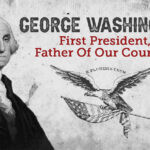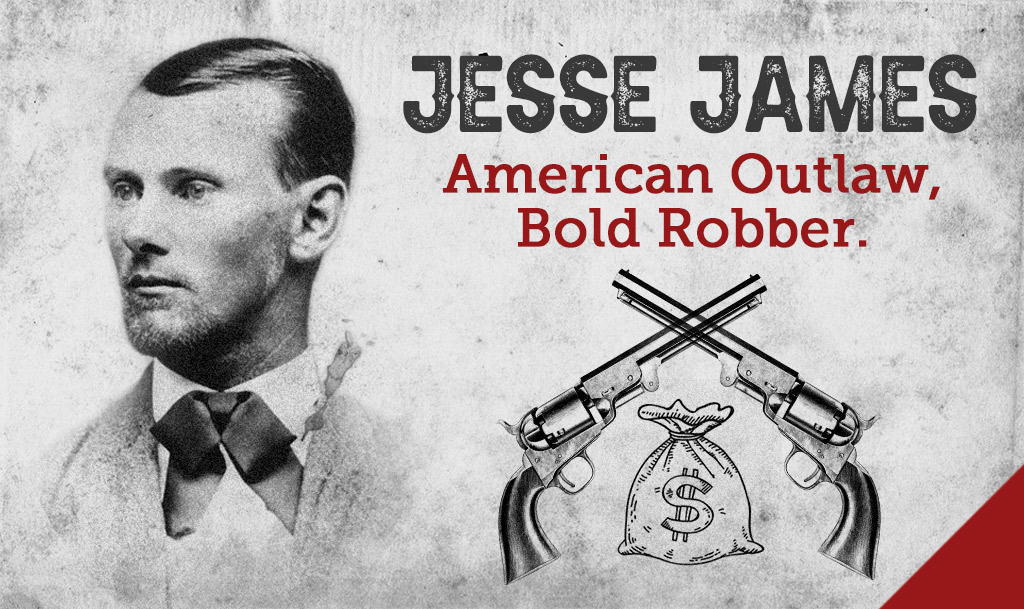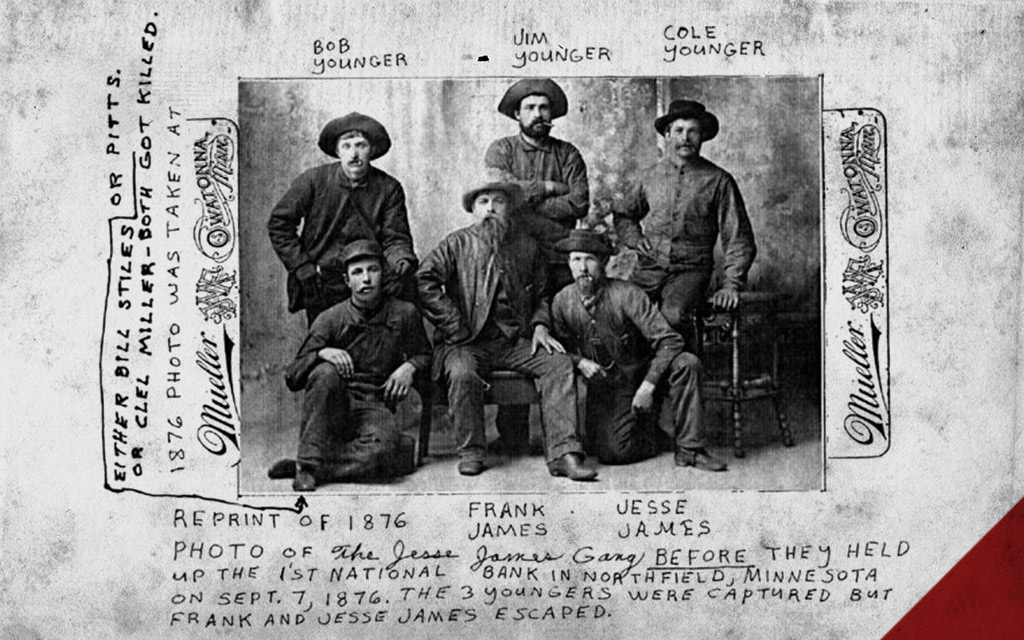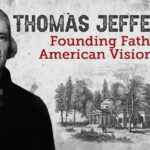

Jesse James did not want to be called a thief. After all, General Ulysses Grant and his Union troops were the real thieves, having stolen everything from James’s beloved South, and Jesse did not want to be associated with the Union Army’s kind of thievery.
After the Civil War ended in defeat for the South, James began building a myth of himself as a Robin Hood. Helping his fellow Missourians who were being crushed by Northern indignations. With the help of a Southern sympathizer and publisher, James was able to build his reputation and make his claims publicly:
“We are not thieves; we are bold robbers. I am proud of the name, for Alexander the Great was a bold robber, and Julius Caesar, and Napoleon Bonaparte.” -Jesse James
Born Into A Southern Family
Jesse James was born in Clay County, Missouri, in 1847 to a hemp-farming family that is believed to have owned slaves. When the Civil War began, 13-year-old Jesse saw his older brother Frank leave the farm to fight for the rebels.
Frank’s eventual association with pro-Confederate guerrillas caused problems for the James family. Jesse, his mother, and stepfather were beaten and tortured for information on Frank’s whereabouts. No one knows what effect this had on teenage Jesse, but in 1864, the now-16-year-old James joined a murderous band of guerrillas led by “Bloody Bill” Anderson.
Jesse participated in several purported atrocities, including the infamous Centralia massacre. Where guerrillas mercilessly executed dozens of both armed and unarmed Union soldiers. There is little doubt that these experiences helped to define Jesse James as he grew into adulthood.
Confederate Ambush

The 1851 Colt revolver was a cap and ball design that held six shots of .36 caliber ammo.
The Confederate guerrillas, also known as “bushwhackers,” focused on ambushing Union troops. They conducted vicious combat at close quarters against the northern invaders. Their primary weapon was the .36-caliber 1851 Navy Colt revolver. Invented by Samuel Colt, the pistol had an automatic, revolving chamber. This allowed the shooter to get off six shots in a row.
The bushwhackers inflicted plenty of damage with their Navy Colts. While Union troops also carried revolvers, their primary weapon was a single-shot Sharpe carbine. The rifles were more accurate and had better range than the pistols, but they took far too long to reload.
As a result, Jesse James and the other guerrillas, each carrying several Colts, could get off dozens of shots while the Union troops were reloading. Since the .36-caliber rounds did more wounding than killing, the bushwhackers finished off their enemies with a headshot when the skirmish was over.
Jesse James’ Revenge
After the war, many former guerrillas reentered civilian life by laying down their weapons and picking up their plows. However, Jesse and Frank James were not at peace. The humiliation of a Northern victory and the disenfranchisement of ex-Confederates made the James brothers feel like victims.
Jesse and Frank chose to continue the fight, and in December of 1869, they rode into the town of Gallatin, Missouri. In broad daylight, shot an unarmed cashier, and escaped with very little to show for their efforts. But by avoiding a posse sent to capture them, their reputation grew, and they later promised they would never be taken alive.
Unlike his brother Frank, Jesse James craved attention and did whatever it took to attract it. He soon began writing his own press releases, leaving them behind in the wake of his robberies.
The Notorious James-Younger Gang

For almost a decade, no bank vault was safe from the notorious James-Younger gang.
While no one can pinpoint the date when the James-Younger Gang was assembled, it lasted from around 1868 until 1876. During their reign of terror, they robbed banks, trains, and stagecoaches in at least eleven states.
The gang was made up of the James brothers, Jesse and Frank, while the Younger brothers consisted of Jim, John, Bob, and Cole. Other former guerrillas who joined temporarily included John Jarrette, Jesse’s brother-in-law, Arthur McCoy, Clell Miller, Matthew Nelson, Charlie Pitts, and Bill Chadwell.
By the time that Jesse James and the gang were robbing banks in the early 1870s, their favorite weapon had become the Colt .45 Peacemaker. Combining the bullet, gunpowder, and percussion cap in one cartridge, the Peacemaker was easy to reload with 45 long colt ammo, meaning Jesse needed only two fully-loaded pistols for each robbery.
But revolvers were not the only weapon the gang carried. They used shotguns to devastating effect during close-range bank robberies, and most of the gang members also carried multi-shot, lever-action Henry and Winchester rifles during their robberies.
Robbery Gone Wrong
On September 7, 1876, eight gang members rode into Northfield, intending to rob the First National Bank. The robbery began with three gang members walking into the bank at 2 p.m. and announcing a hold-up.
They ordered the three bank employees to open the safe, but the workers claimed the door could not be unlocked. As this was happening inside the bank, some of the locals were arming themselves after one of the town’s merchants discovered the robbery in progress. They quickly alerted others in the town.
Two gang members began firing their pistols and warning the townspeople to clear out or be shot. Soon, the remaining robbers were forced to enter the fight. A Swedish town resident named Nicholas Gustafson was the first to fall. Shot in the head, he died several days later.
As the Northfield citizens surrounded the bank, they killed gang members Clell Miller and Bill Chadwell as they tried to escape. Jesse’s brother, Frank, was shot in the leg, while three of the Younger brothers—Jim, Cole, and Bob–were severely wounded. Jesse was the last to leave the bank but not before putting a bullet into the cashier’s head. Taking his revenge on the employee who had refused to open the safe.
After just seven minutes of fighting, the survivors desperately fled Northfield empty-handed. A posse pursued the gang for two weeks and eventually killed or captured four more gang members. Jesse and Frank James had split from the rest of the group and escaped to Dakota Territory. They would end up living in Tennessee under assumed names.
The Assassination Of Jesse James

Legend has it that Jesse James was shot in the back of the head while dusting a picture frame.
Frank James enjoyed the quiet life, but Jesse James did not. He found it impossible to settle down with his wife and son, returning to crime in 1879. James formed a new gang, but none of them were either ex-Confederates or believed in his cause. They were simply in it for the money.
One of his gang members, Bob Ford, was a traitor. He was conspiring with Missouri’s governor to hunt the infamous outlaw down and collect a $10,000 reward. Jesse James seldom took his revolvers off, but on a hot day in April of 1882, James removed his coat and guns as he planned his next robbery at his house in St. Joseph, Missouri.
It was the first time Ford had seen Jesse without his guns. He seized the opportunity by drawing his revolver and shooting Jesse in the back of the head.
The Legacy Of Jesse James
Jesse James died with very few supporters. Only those who had known and protected him during his years as an outlaw remained loyal. Even standing up for him after he was killed. But as time passed, the myth surrounding him grew to the point that it overshadowed the truth of his violent life.
He has been the source of numerous films, songs, books, articles, and movies. Some parents have even named their sons after him! Everything about him is surrounded by controversy, but one thing is sure—interest in Jesse James has not subsided over the last 150 years or so. And for someone who sought attention, that would make the American outlaw quite happy!


